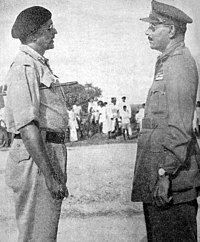Hyderabad State (1948–1956)
| Hyderabad State | |||||||||||||
|---|---|---|---|---|---|---|---|---|---|---|---|---|---|
| State of India | |||||||||||||
| 1948–1956 | |||||||||||||
 Hyderabad in India (1951) | |||||||||||||
| Area | |||||||||||||
| • Coordinates | Coordinates: 17°00′N 78°50′E / 17.000°N 78.833°E | ||||||||||||
| History | |||||||||||||
| History | |||||||||||||
• Hyderabad State formed from Hyderabad Princely State | 1948 | ||||||||||||
• Reorganized and renamed Andhra Pradesh | 1956 | ||||||||||||
| |||||||||||||
| Today part of | Telangana Maharashtra Karnataka | ||||||||||||
| States of India since 1947 | |||||||||||||
Hyderabad State was a state in Dominion and later Republic of India, formed after the accession of the princely state of Hyderabad into the Indian Union on 17 September 1948.[1] It existed from 1948 to 1956.
Following the States Reorganisation Act, which implemented a linguistic reorganization of states, the Hyderabad state was dissolved. Its different sections were merged with Andhra State, Mysore State and Bombay State respectively.[2]
History[edit]
{{#section:Annexation of Hyderabad|Lead}}
Military Governor[edit]

After the Annexation into the Indian Union, Major General J. N. Chaudhuri who led Operation Polo stayed on as Military Governor till December 1949.
The state witnessed Mulkhi agitation in 1952 by the locals after government jobs meant for the locals were given to non-locals.
Rajpramukh[edit]
Hyderabad State had its last Nizam, HEH Mir Osman Ali Khan (1886–1967) as Rajpramukh from 26 January 1950 to 31 October 1956.
First Appointed Chief Minister[edit]
After the Annexation of Hyderabad State into India, M. K. Vellodi was appointed the Chief Minister of the state on 26 January 1950. He was a Senior Civil servant in the Government of India. He administered the state with the help of bureaucrats from Madras state and Bombay state.
The 7th Nizam – Mir Osman Ali Khan was given the ceremonial position of "Raj Pramukh" or "Governor".
First Elected Chief Minister[edit]
In the first State Assembly election in India, 1952, Dr. Burgula Ramakrishna Rao was elected Chief minister of Hyderabad State. During this time there were violent agitations by some Telanganites to send back bureaucrats from Madras state, and to strictly implement 'Mulki-rules'(Local jobs for locals only), which was part of Hyderabad state law since 1919.[3]
Districts of Hyderabad State[edit]
Administratively, Hyderabad State was made up of sixteen districts, grouped into four divisions:
- Aurangabad Division included Aurangabad, Beed, Nanded, and Parbhani districts;
- Gulbarga Division included Bidar District, Gulbarga, Osmanabad (present Latur district was part of Osmanabad district) and Raichur District;
- Gulshanabad Division or Medak Division included Atraf-i-Baldah (Hyderabad), Mahbubnagar district, Medak district, Nalgonda district (Nalgundah), and Nizamabad districts, and
- Warangal Division included Adilabad, Karimnagar, and Warangal districts (present Khammam district was part of Warangal district).
Linguistic Reorganization[edit]
In 1956 during the Reorganisation of the Indian States based along linguistic lines, the Telugu-speaking region of the state of Hyderabad State was merged with Andhra State. The Marathi speaking region was merged with Bombay state and Kannada speaking region with Mysore State.
The States Reorganisation Commission (SRC) was not in favour of an immediate merger of Telugu speaking Telangana region of Hyderabad state with Andhra state, despite their common language. Para 378 of the SRC report said One of the principal causes of opposition of Vishalandhra also seems to be the apprehension felt by the educationally backward people of Telangana that they may be swamped and exploited by the more advanced people of the coastal areas.
Andhra state and Hyderabad State were merged to form Andhra Pradesh on 1 November 1956, after providing safeguards to Telangana in the form of Gentlemen's agreement. But in June 2014, Telangana re-emerged as a separate state. Hyderabad City will continue to be the capital of both Andhra Pradesh and Telangana for 10 years.
Chief Ministers of Hyderabad State[edit]
Hyderabad State included nine Telugu districts of Telangana, four Kannada districts in Gulbarga division and four Marathi districts in Aurangabad division.
| No | Name | Portrait | Term of office | Party[lower-alpha 1] | Days in office | ||
|---|---|---|---|---|---|---|---|
| 1 | M. K. Vellodi | 
|
26 January 1950 | 6 March 1952 | Independent (civil service) | 770 | |
| 2 | Burgula Ramakrishna Rao | 
|
6 March 1952 | 31 October 1956 | Indian National Congress | 1701 | |
See also[edit]
Notes[edit]
- ↑ This column only names the chief minister's party. The state government he headed may have been a complex coalition of several parties and independents; these are not listed here.
References[edit]
- ↑ "Hyderabad had tried 'NRC' 71 years ago, and failed". The Times of India. 15 September 2019.
- ↑ "States Reorganization Act 1956". Commonwealth Legal Information Institute. Archived from the original on 16 May 2008. Retrieved 1 July 2008.
- ↑ "Mulki agitation in Hyderabad state". Hinduonnet.com. Archived from the original on 26 August 2010. Retrieved 9 October 2011.
Cite error: <ref> tag with name "BBC Hyderabad 1948" defined in <references> is not used in prior text.
<ref> tag with name "ShermanLSE" defined in <references> is not used in prior text.Further reading[edit]
- Sherman, Taylor C. (2007). "The integration of the princely state of Hyderabad and the making of the postcolonial state in India, 1948 – 56" (PDF). Indian Economic & Social History Review. 44 (4): 489–516. doi:10.1177/001946460704400404. S2CID 145000228.

